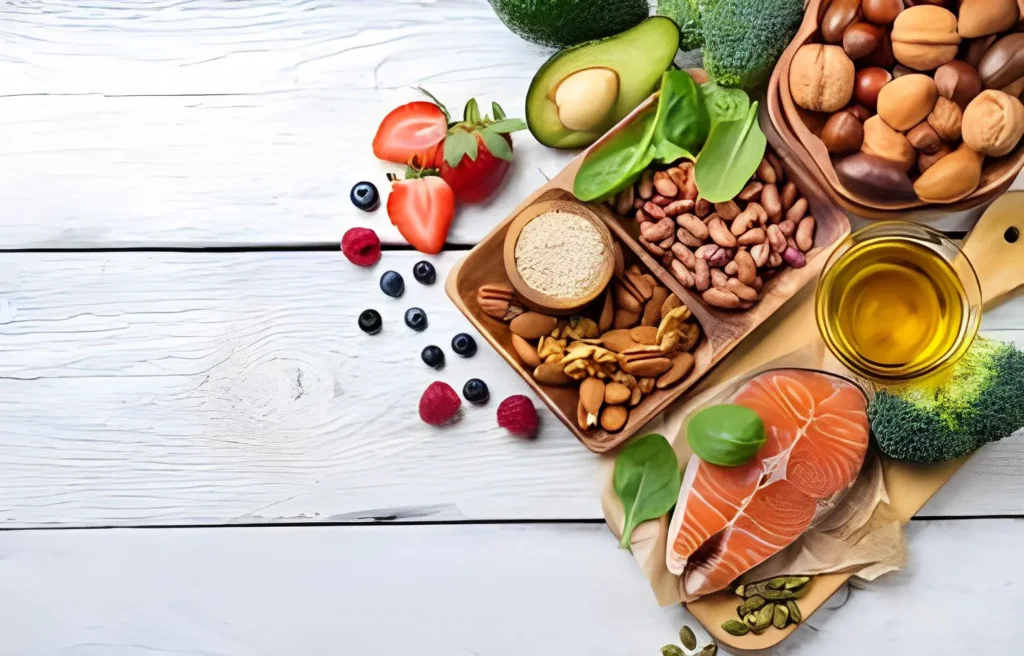Have you ever wondered if there’s a way to eat delicious food and support your health at the same time? Well, a low-fat diet plan might be the answer you’ve been searching for!
So, what exactly is a low-fat diet plan? It’s an approach to eating that emphasizes limiting your intake of fat, particularly unhealthy fats like saturated and trans fats, while prioritizing nutrient-rich foods like fruits, vegetables, whole grains, and lean protein.
But why would you choose to follow a low-fat diet plan? The potential benefits are numerous! Research suggests that reducing your fat intake can lead to:
- Successful weight management: Studies show that low-fat diets can be effective for weight loss and maintaining a healthy weight [1].
- Improved heart health: Lowering your intake of unhealthy fats can contribute to lowering cholesterol levels and reducing the risk of heart disease [2].
- Enhanced overall well-being: A balanced low-fat diet rich in fruits, vegetables, and whole grains can provide essential vitamins, minerals, and fiber to support your overall health and well-being [3].
Is a low-fat diet plan right for everyone? While it offers numerous advantages, it’s important to consult with a healthcare professional or registered dietitian before starting any new diet plan. They can help you determine if a low-fat approach aligns with your individual needs and health goals.
Ready to delve deeper into the world of low-fat eating? Stay tuned as we explore the different types of fats, build delicious and nutritious meal plans, and uncover tips for sustainable success on your low-fat journey!
Sources:
I. Understanding Fats: Not All Fats Are Created Equal:

Ever wondered why some fats get a bad rap while others are hailed as health heroes? Buckle up, because we’re diving into the fascinating world of dietary fats!
Think of fats as tiny building blocks: some are sturdy and inflexible (saturated fats), while others are more bendy and adaptable (unsaturated fats). This very structure determines their impact on our health.
Saturated fats: These rigid fellas are often found in animal products like fatty meats, full-fat dairy, and processed foods. While they’re not inherently evil, consuming too much can elevate bad cholesterol levels, increasing your risk of heart disease.
Unsaturated fats: Now, these superstars come in two flavors: monounsaturated and polyunsaturated. Think of them as the “good fats.” They help lower bad cholesterol, boost good cholesterol, and even promote heart health. You’ll find them in olive oil, avocados, nuts, seeds, and fatty fish like salmon.
Trans fats: These villains are the result of processing vegetable oils. They’re notoriously linked to a plethora of health problems, including heart disease, stroke, and even type 2 diabetes. They’re best avoided altogether.
So, what does this mean for your low-fat diet plan? While reducing overall fat intake is important, focusing on replacing saturated and trans fats with healthy unsaturated fats is key. This way, you’re not just cutting back on fat, you’re actively promoting your overall well-being.
Remember, healthy fats are essential for numerous bodily functions, including:
- Brain development and function
- Hormone production
- Nutrient absorption
- Cell growth and repair
So, don’t be afraid to embrace the good fats! By incorporating them into your low-fat diet plan, you’re setting yourself up for a healthier, happier you.
II. Building a Low-Fat Diet Plan: Delicious and Nutritious Choices:

Ever feel overwhelmed by the idea of creating delicious and satisfying meals on a low-fat diet plan? Fear not! This section is your guide to building a balanced and flavorful low-fat eating pattern that fuels your body and keeps your taste buds happy.
Let’s dive into the essential food groups that form the foundation of a healthy low-fat diet plan:
Fruits: Aim for 2-4 servings daily. Fresh, frozen, or canned fruits in water are excellent choices. Think berries, apples, pears, melons, and citrus fruits. Love smoothies? Blend your favorite fruits with low-fat yogurt or unsweetened plant-based milk for a refreshing and nutritious breakfast or snack.
Vegetables: Non-starchy vegetables are your friends! Aim for 3-5 servings daily. Explore the vibrant world of leafy greens like spinach, kale, and romaine lettuce. Don’t forget broccoli, cauliflower, bell peppers, and mushrooms. Roasting, grilling, or steaming vegetables preserves their nutrients and enhances their natural flavors.
Whole Grains: Opt for 3-5 servings daily. Whole grains provide sustained energy and essential dietary fiber. Choose brown rice, quinoa, whole-wheat bread and pasta, oats, and barley. Looking for a quick and satisfying breakfast? Top whole-wheat toast with sliced avocado and a sprinkle of everything bagel seasoning for a delicious and low-fat option.
Lean Protein: Include 1-2 servings of lean protein sources daily. Chicken, turkey, fish, beans, lentils, and tofu are all excellent choices. Skinless, boneless chicken breasts baked with lemon and herbs or grilled salmon with roasted vegetables are simple yet flavorful low-fat protein options.
Low-Fat Dairy: Enjoy 1-2 servings daily. Opt for low-fat or fat-free milk, yogurt, and cheese. Greek yogurt with berries and a sprinkle of granola makes for a protein-packed and satisfying snack. Remember, low-fat doesn’t have to mean flavorless! Explore different options to find your favorites.
Now, let’s put these principles into action with a sample low-fat meal plan:
Breakfast:
- Greek yogurt parfait with berries, granola, and a drizzle of honey
- Whole-wheat toast with scrambled eggs and sliced avocado
Lunch:
- Tuna salad sandwich on whole-wheat bread with lettuce and tomato
- Lentil soup with a side salad
Dinner:
- Baked salmon with roasted vegetables and brown rice
- Chicken stir-fry with colorful vegetables and brown rice noodles
Snacks:
- Apple slices with almond butter
- Carrot sticks with hummus
- Air-popped popcorn with a sprinkle of nutritional yeast
Beyond these examples, remember these key tips for successful low-fat meal planning:
- Plan and prep meals in advance: This saves time and prevents unhealthy choices when hunger strikes.
- Read food labels: Pay attention to fat content and serving sizes.
- Cook at home more often: This gives you control over ingredients and portion sizes.
- Substitute high-fat ingredients with low-fat alternatives: Use low-fat yogurt instead of sour cream, or applesauce instead of oil in baking.
Remember, consistency is key! By incorporating these strategies and exploring the vast array of delicious low-fat options, you can create a sustainable and enjoyable eating pattern that supports your health goals.
Feeling inspired to embark on your low-fat diet journey? Share your favorite low-fat recipes and tips in the comments below!
III. Lifestyle Changes for Sustainable Success:

Ever wonder how to make your low-fat diet plan a lasting lifestyle change? It’s true, healthy eating goes hand-in-hand with other healthy habits for optimal results and long-term success. Let’s explore some key lifestyle changes that can boost your low-fat diet journey:
1. Move your body! Regular physical activity is crucial for weight management, heart health, and overall well-being. Aim for at least 150 minutes of moderate-intensity exercise or 75 minutes of vigorous-intensity exercise per week, according to the Centers for Disease Control and Prevention (CDC). Don’t be intimidated – even small changes like taking the stairs, going for a brisk walk, or joining a dance class can make a big difference.
2. Prioritize sleep. When you’re well-rested, you’re better equipped to make healthy choices and manage stress. Strive for 7-8 hours of quality sleep each night. Create a relaxing bedtime routine, establish a consistent sleep schedule, and limit screen time before bed.
3. Manage stress effectively. Chronic stress can wreak havoc on your health and sabotage your diet efforts. Find healthy ways to manage stress, such as yoga, meditation, deep breathing exercises, spending time in nature, or connecting with loved ones.
Remember, these lifestyle changes aren’t just about achieving quick results; they’re about building sustainable habits for a healthier, happier you.
By incorporating these tips alongside your low-fat diet plan, you’ll be well on your way to lasting success!
Conclusion:
So, you’ve delved into the world of low-fat eating, understanding the different types of fats, and explored delicious meal options. But remember, a low-fat diet plan is just the beginning of a sustainable and healthy lifestyle.

Are you ready to take the next step?
Here’s the exciting part: This journey is unique to you! Experiment with different recipes, find what keeps you motivated, and don’t be afraid to seek guidance from a registered dietitian or healthcare professional for personalized advice. Remember, consistency is key, and celebrating small victories along the way will fuel your long-term success.
Ready to explore further? The American Heart Association offers fantastic resources on heart-healthy eating, while the Academy of Nutrition and Dietetics provides valuable insights into understanding healthy fats.
Embark on your low-fat diet plan with confidence, knowing you’re making informed choices for your well-being. Remember, small changes can lead to big results!
Don’t miss: Easy Vegetarian Meals: A Comprehensive Guide & Delicious Recipes
People Also Ask:
Is a low-fat diet safe for everyone?
What are some common challenges of following a low-fat diet?
How can I stay motivated on a low-fat diet?
Are there any potential drawbacks to a low-fat diet?
What if I have specific dietary restrictions or allergies?
Can a low-fat diet help lower cholesterol?
How long does it take to see results on a low-fat diet?
What can you eat on a very low-fat diet?
What is typically in a low-fat diet?
Fruits and vegetables: Aim for at least 5 servings daily for essential vitamins and fiber.
Whole grains: Choose brown rice, quinoa, whole-wheat bread, and oats for sustained energy.
Lean protein: Opt for skinless chicken, fish, beans, lentils, and tofu for building and repairing tissues.
Low-fat dairy: Enjoy low-fat yogurt, skim milk, and low-fat cheese for calcium and other nutrients.
What is a low-fat meal plan?
What is an example of a low-fat meal?
Lunch: Grilled chicken salad with whole-wheat bread and low-fat dressing
Dinner: Baked salmon with roasted vegetables and brown rice
Snack: Greek yogurt with fruit and a handful of almonds